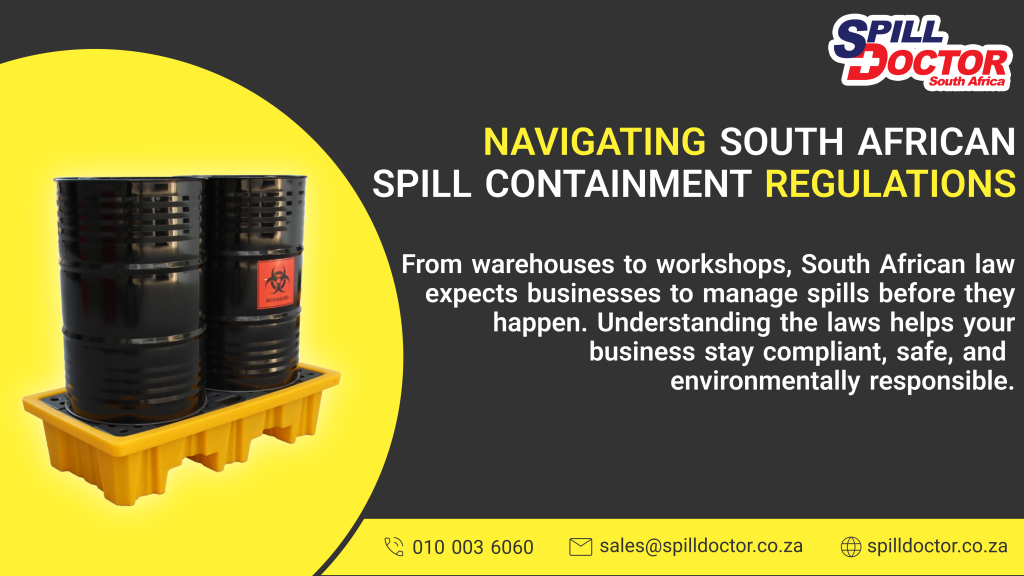
Navigating South African Spill Containment Regulations especially when it comes to hazardous liquids and chemical storage, South African businesses have a clear legal obligation: managing spills effectively is not optional. Proper spill containment is critical not only for environmental protection but also for workplace safety and regulatory compliance. This article breaks down the key regulations, compliance requirements, and practical steps you can take to ensure your business stays on the right side of the law.
Key Regulations Governing Spill Containment in South Africa
South Africa’s legal framework addresses spill containment through a combination of environmental laws and occupational health and safety standards:
National Environmental Management Act (NEMA) specifically Chapter 7, Section 28, businesses have a “duty of care” to prevent environmental harm. This includes taking reasonable measures to contain hazardous spills.
The National Environmental Management: Waste Act (NEM:WA) chapter 2, provides the overarching framework for waste management in South Africa, requiring businesses to comply with waste containment and handling standards as specified by national strategies and regulations developed under this Act.
Occupational Health and Safety Act (OHSA) section 8(1)(2): Employers must provide a safe workplace, minimizing workers’ exposure to hazardous substances through appropriate containment and spill management systems.
Common Compliance Requirements:
To meet these legal obligations, businesses typically need to implement:
Secondary containment systems such as spill pallets, and bunded flooring are designed to hold at least 110% of the largest container’s volume or 25% of the total volume of all containers being stored, whichever is greater as outlined in the National Environmental Management: Waste Act: NORMS AND STANDARDS FOR THE STORAGE OF WASTE. As well as routine inspections and maintenance of storage areas and containment equipment to identify and address risks proactively.
Challenges and Consequences of Non-Compliance
Failing to comply with spill containment regulations can result in:
- Significant financial penalties and fines from environmental authorities.
- Work stoppages or shutdowns imposed by regulators.
- Damage to your business reputation through negative publicity.
- Long-term environmental damage with costly remediation efforts.
- Increased risk of workplace injuries or health issues for employees.
How Spill Doctor Supports Your Compliance Journey:
At Spill Doctor, We believe that proactive behaviour is necessary for the manufacturing, storage and transporting of hazardous materials or products. Should you not be prepared in the event of a spillage, your company may be liable for the environmental damage caused by the spillage which could result in hefty fines or imprisonment if found negligent. It is vitally important that you have both proactive and reactive procedures in place for any small or large spillages.
Understanding and complying with South Africa’s spill containment regulations isn’t just about avoiding fines — it’s about protecting your people, your environment, and your business. With the right knowledge and equipment, you can confidently meet legal requirements and build a safer workplace.
If you’re unsure about your current spill containment measures or need expert advice, contact us today.
Additionally, our full range or Spill Pallets, Drip trays, Drum Trolleys, etc. can be found here.
